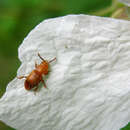fr
noms dans le fil d’Ariane


Antherophagus is a genus of silken fungus beetles in the family Cryptophagidae. There are at least four described species in Antherophagus.[1][2][3]
ITIS Taxonomic note:[2]
Antherophagus is a genus of silken fungus beetles in the family Cryptophagidae. There are at least four described species in Antherophagus.
ITIS Taxonomic note:
The genus name Antherophagus has been variously attributed to Dejean 1821:45 (e.g., Leschen 1996:587) or to Latreille 1829:507 (e.g., Bousquet 1989:12). Under the current International Code of Zoological Nomenclature, Dejean's use is now considered valid by indication with the type species being designated by Westwood, as cited by Leschen (pers. comm., Dr. Paul Skelley, January 2013).Antherophagus is een geslacht van kevers uit de familie dwergschimmelkevers (Cryptophagidae). De wetenschappelijke naam van het geslacht is voor het eerst geldig gepubliceerd in 1821 door Dejean.[1]
Dit geslacht komt voor in Zuid-Amerika, Zuid-Oost-Azië en het Holarctisch gebied.[2] De kevers verblijven op bloemen en klampen zich vast aan hommels (Bombus) die de bloemen bezoeken, om zich zo naar hun nest te laten vervoeren (een proces dat foresie wordt genoemd), wellicht met de bedoeling om daar hun eitjes te leggen; de larven leven dan van het stuifmeel en ander materiaal in de hommelnesten.[3]
Bronnen, noten en/of referenties